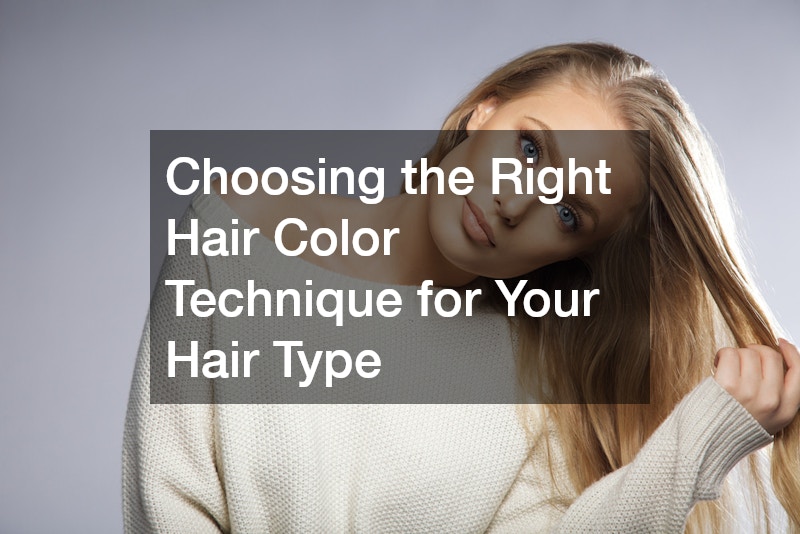When selecting a hair color technique, understanding how different methods work with your specific hair type can make a significant difference in achieving your desired look. Hairdressers often encounter clients with various hair textures and thicknesses, each requiring unique approaches to coloring. Whether you have fine or thick hair, knowing the best techniques to use can help you get the most natural and flattering results.
Color Techniques for Fine Hair
For those with fine hair, the challenge lies in creating a soft, blended look that doesn’t accentuate the hair’s fineness. Fine hair can be delicate and often lacks the volume needed to achieve a seamless gradient with some coloring techniques.
Many clients with fine hair come in hoping for a soft, natural-looking balayage or ombre, but they may find that their results don’t match their expectations.
Hairdressers recommend starting the color application a bit lower on the hair. This approach provides more space to work with and allows for better blending and softness at the roots. By starting the color application lower, you avoid the abrupt lines that can occur when color starts too high on fine hair.
Combining baby lights with balayage can be particularly effective. Baby lights involve applying very fine, subtle highlights that blend naturally with the hair color. When mixed with balayage—a technique that involves painting color onto the hair in a sweeping motion—this combination helps achieve a soft, gradual transition from root to tip. This method allows for more subtle color changes and minimizes the stark lines that are often seen with other techniques.
It’s important to manage expectations; while you can achieve a beautiful, soft look with fine hair, it may not look exactly like images you bring in if they feature models with thicker hair. Hairdressers often note that clients might bring in pictures of looks that are not feasible with their current hair type. Fine hair may require more than one session to reach the desired softness and natural appearance. Patience and gradual coloring can result in a look that mimics the natural lightness seen in sun-bleached hair.
Color Techniques for Thick Hair
Thick hair presents a different set of challenges and opportunities when it comes to coloring. For clients with thick, coarse hair, hairdressers typically recommend a different approach to avoid overwhelming the hair with too many highlights or colors. Thick hair can handle more intense coloring, but it’s crucial to avoid creating a chunky or overly voluminous look.
A more rooty, relaxed color technique often works best for thicker hair. By allowing more of the natural root color to show through, the overall look can be balanced and more harmonious. This approach prevents the color from appearing too heavy or adding unnecessary volume, which can be a concern with already voluminous hair.
When highlighting thick hair, hairdressers may use fewer highlights or focus on strategic placement to create a more balanced appearance. Rather than applying highlights throughout the entire length of the hair, which can lead to a dense and unnatural look, a more selective approach helps achieve a refined and less overwhelming effect.
Coloring to Enhance Facial Features
In addition to choosing the right technique based on hair type, color placement can also be used to enhance or conceal facial features. For example, adding lightness to certain areas of the hair can accentuate features you want to highlight or soften features you’d prefer to downplay. This technique can be particularly useful for clients looking to adjust the visual impact of their face shape or features.
Hairdressers can use color strategically to create a flattering effect. For instance, lighter colors around the face can draw attention to specific features, while darker shades can help reduce the focus on less desired areas. This approach allows for greater control over how the color complements your overall appearance.
Consulting with Hairdressers
When considering a new hair color technique, consulting with experienced hairdressers is essential. They can provide personalized advice based on your hair type, texture, and desired outcome. A skilled hairdresser can also help manage expectations and offer realistic solutions to achieve the best possible result.
Hairdressers often work closely with clients to understand their vision and recommend the most suitable techniques. By discussing your hair type and desired look, you can collaborate to choose a coloring method that aligns with your goals and enhances your natural beauty.
In summary, choosing the right hair color technique involves understanding how different methods work with your specific hair type. Fine hair benefits from starting color lower and combining baby lights with balayage to achieve softness. Thick hair, on the other hand, benefits from a more rooty, relaxed look to avoid adding excess volume. Additionally, strategic color placement can enhance or conceal facial features for a more personalized touch. Consulting with hairdressers can provide valuable insights and ensure you achieve a look that complements your hair and enhances your overall appearance.
.







